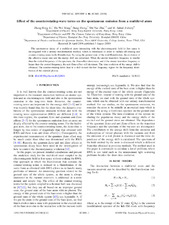| dc.creator | Li, Zheng-Hong | |
| dc.creator | Wang, Da-Wei | |
| dc.creator | Zheng, Hang | |
| dc.creator | Zhu, Shi-Yao | |
| dc.creator | Zubairy, M. Suhail | |
| dc.date.accessioned | 2011-09-08T21:36:36Z | |
| dc.date.available | 2011-09-08T21:36:36Z | |
| dc.date.issued | 2009 | |
| dc.identifier.citation | Zheng-Hong Li, Da-Wei Wang, Hang Zheng, Shi-Yao Zhu and M. Suhail Zubairy. Phys.Rev.A 80 023801 2009. "Copyright (2009) by the American Physical Society." | en |
| dc.identifier.uri | http://dx.doi.org/10.1103/PhysRevA.80.023801 | |
| dc.identifier.uri | https://hdl.handle.net/1969.1/126632 | |
| dc.description | Journals published by the American Physical Society can be found at http://publish.aps.org/ | en |
| dc.description.abstract | The spontaneous decay of a multilevel atom interacting with the electromagnetic field in free space is investigated with a unitary transformation method, which is introduced in order to include all rotating and counter-rotating terms in the Hamiltonian. By using the ground state of the total Hamiltonian, the evolution of the effective decay rate and the energy shift are calculated. When the atomic transition frequency is smaller than the central frequency of the spectrum, the Zeno effect dominates, and if the atomic transition frequency is larger than the central frequency, the anti-Zeno effect will dominate. The time evolution of the energy shift is obtained. The counter-rotating terms lead to a shift toward the low frequency region for the frequency distribution of the emitted photon. | en |
| dc.language.iso | en | |
| dc.publisher | American Physical Society | |
| dc.subject | QUANTUM ZENO | en |
| dc.subject | HYDROGEN-ATOM | en |
| dc.subject | DECAY | en |
| dc.subject | Optics | en |
| dc.subject | Physics | en |
| dc.title | Effect of the counterrotating-wave terms on the spontaneous emission from a multilevel atom | en |
| dc.type | Article | en |
| local.department | Physics and Astronomy | en |


